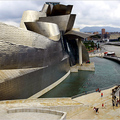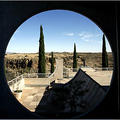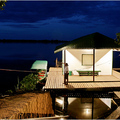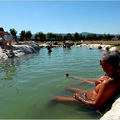IT seemed as though the entire population of Tuscany was congregating on Il Campo, the famous, shell-shaped piazza in Siena, snacking on bread, salumi, cheese and panforte, the famous Sienese cake. The crush of bodies in the shadow of the 335-foot clock tower, the Torre del Mangia, suggested what the place must be like at the Palio, the annual horse races staged each summer. Not unlike Jones Beach in mid-July, minus the sand and exposed flesh. But this was Pasquetta, or Little Easter, an Italian national holiday.
“Natale con i tuoi, Pasqua con chi vuoi,” is the Italian saying: “Christmas with family, Easter with whomever you choose;” and on Pasquetta, Easter Monday, there is an implied corollary for those holed up in larger cities: “Grab that ‘whomever’ and get out of town.” For Pasquetta, the idea is “gite fuori porta,” to go outside of the city. For Florentines, it seems, a smaller Tuscan city, like Siena, qualifies as an appropriate escape.
“All political, cultural, and productive activities slow down a lot,” our friend Mario Tedeschini-Lalli, had told me by e-mail message, explaining that he and his wife, Silvia Baffoni, a doctor, would borrow a van and collect my husband, two daughters and me at our hotel in Florence and drive to Siena on the day after Easter. Just about everything shuts down, he explained. Although Mario and Silvia are Catholics, I detected a note of humor in his postscript: “And there’s no church involved whatsoever.”
The roots of the holiday, however, are indeed religious. It is also called Lunedì dell’Angelo (Angel’s Monday), and commemorates, as Pope John Paul II said on Easter Monday 2002, “the heavenly messenger’s meeting with the women who had hastened to [Christ’s] tomb,” and who heard the message “He is not here, for he has risen.”
But the celebration of the day itself has a carefree feel. Schools in Italy are generally closed from the Wednesday before Easter, or Pasqua, to the Wednesday after. Pasquetta offers a release from the serious religious rituals of the preceding days.
“In Italy, people are transformed around Easter,” said Stew Vreeland, a consultant from Yarmouth, Me., who has a house in the Umbrian village of Panicale, and who markets Italian real estate. “You see your neighbors, usually happy, social, fun-loving people, and they are following the Stations of the Cross on Good Friday with their eyes cast down. It’s very, very serious.”
Carol Field of San Francisco, author of “Celebrating Italy,” says that “Easter is just huge in Italy, much bigger than it is in the United States. Bigger than Christmas.” And, she added, “You can’t have Easter without Pasquetta.”
In fact, the entire point of Pasquetta, Ms. Field said, is “to allow people to eat themselves into a stupor.” She recalled a Little Easter spent in Sicily in which “pyramids” of roasted artichokes were stacked on the table, and the menu included a frittata of wild asparagus, melted sheep cheese, lamb grilled with spring onions, a salad of wild greens, plenty of local wine and a platter of sweets. A neighboring picnic, she said, included 125 pounds of beef and pork, and an entire sheep.
We witnessed nothing on that scale, but on the trip from Florence to Siena along the Chiantigiana (SS 222, which winds through the Chianti region), we had seen families camped a few feet from their parked cars and picnicking. Some towns hold food festivals: in Fontanelice, in Emilia-Romagna, for example, the Festa della Piè Fritta is held on Pasquetta, to celebrate the local specialty — piadina, an unleavened bread.
James Dominic, of Via Travel Design in Philadelphia, which rents luxury vacation homes in Italy, recalls spending Pasquetta at the Festa di Focacette — feast of the small focaccia — in the tiny village of Megli, south of Genoa. There, the thin breads were cooked on large, cast-iron griddles, and “a lot of eating and drinking ensued.”
“Every little pocket in Italy does it differently,” said Lynne Rossetto Kasper, an authority on Italian cooking and host of the public radio show “The Splendid Table.” She recalls spending the holiday with her relatives on a farm in Monte San Quirico in Tuscany, in which “the whole idea was to get out into the meadow and celebrate the return of spring.” The family gathered wild greens for the feast and dined on rabbit with olives and sage and an Easter pie filled with fresh ricotta, orange zest, raisins, eggs and rum.
While working on her book “The Italian Country Table,” Ms. Kasper said that she interviewed a priest about how the liturgical calendar follows the agricultural seasons. “He pointed out that Pasquetta was a time to reaffirm that warmth and light have returned to the earth,” she said.
In Siena, where we rested on sun-warmed brick rather than earth, our Pasquetta feast consisted of provisions purchased when we were swept along the narrow, arched passageways into a large deli on our way to the Campo. We bought bread and prosciutto, olives, oranges, cheese and bottled mineral water. Dessert, in Siena, is a no-brainer, as the city is famous for its panforte, a thin cake dense with nuts and dried fruits. It is sold in markets in huge wheels and sliced off with sharp cleavers into snacking-size hunks. We obtained a relatively large piece, wrapped in butcher paper and string, and carried off our prize to the piazza.
In some places, there is more to Little Easter than eating. From the hundreds of Spandex-clad cyclists we saw cruising through Chianti, it was clearly a day for bike touring, at least on the way to a picnic.
Mr. Vreeland tells of the Ruzzolone in Panicale — the rolling of the cheese. A sporting event that combines elements of bocce and yo-yo, it is, Mr. Vreeland says, “as crazy as it sounds.” The giocatori, or players, send a nine-pound round of Pecorino cheese rolling on a course around the perimeter of the ancient, walled village. It is launched with a leather strap, wrapped around the cheese and pulled by a stick of wood. Spotters run alongside the cheese to mark where it falls. The winner — the player who completes the race course in the fewest strokes — gets the cheese.
Often the cheeses go careening into nearby olive groves or, as Mr. Vreeland wrote on his Web site, www.seeyouinitaly.com, “get wedged under the one Fiat Uno that didn’t get the No Parking message.” When the race is completed, the crowd is entertained by a bandaccia (literally “bad band”), with people playing pots, pans, cowbells, horns and a few actual instruments.
Although the holiday requires no churchgoing, our group decided to tour the storied Duomo in Siena, the striped campanile giving us a clue to the dizzyingly busy interior. I simply remember the church — which reminded my older daughter, Hannah, of an Easter egg — as a stripy, colorful blur.
Toward late afternoon, Mario and Silvia dropped us at the train station, just outside of the city walls, for our trip back to Florence while they headed home to Rome. We crowded aboard the train with dozens of cyclists, carrying their state-of-the-art, featherweight bikes aboard. We found seats warmed by the late-afternoon sun, and we nibbled the rest of our panforte.






